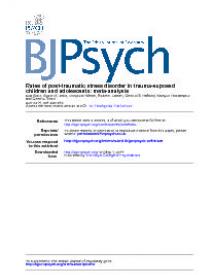Rates of post-traumatic stress disorder in trauma-exposed children and adolescents: meta-analysis.
BACKGROUND: It is unclear how many children and adolescents develop post-traumatic stress disorder (PTSD) after trauma. AIMS: To determine the incidence of PTSD in trauma-exposed children and adolescents as assessed with well-established diagnostic interviews and to examine potential moderators of the estimate. METHOD: A systematic literature search identified 72 peer-reviewed articles on 43 independent samples (n = 3563). Samples consisting only of participants seeking or receiving mental health treatment were excluded. Main analyses involved pooled incidence estimates and meta-analyses of variance. RESULTS: The overall rate of PTSD was 15.9% (95% CI 11.5-21.5), which varied according to the type of trauma and gender. Least at risk were boys exposed to non-interpersonal trauma (8.4%, 95% CI 4.7-14.5), whereas girls exposed to interpersonal trauma showed the highest rate (32.9%, 95% CI 19.8-49.3). No significant difference was found for the choice of assessment interview or the informant of the assessment. CONCLUSIONS: Research conducted with the best available assessment instruments shows that a significant minority of children and adolescents develop PTSD after trauma exposure, with those exposed to interpersonal trauma and girls at particular risk. The estimates provide a benchmark for DSM-5 and ICD-11.
Geachte bezoeker,
De informatie die u nu opvraagt, kan door psychotraumanet niet aan u worden getoond. Dit kan verschillende redenen hebben,
waarvan (bescherming van het) auteursrecht de meeste voorkomende is. Wanneer het mogelijk is om u door te verwijzen naar de bron
van deze informatie, dan ziet u hier onder een link naar die plek.
Als er geen link staat, kunt u contact opnemen met de bibliotheek,
die u verder op weg kan helpen.
Met vriendelijke groet,
Het psychotraumanet-team.
In: The British Journal of Psychiatry, ISSN 0007-1250 | 204 | 5 | 335-340
http://www.ncbi.nlm.nih.gov/pubmed/24785767


